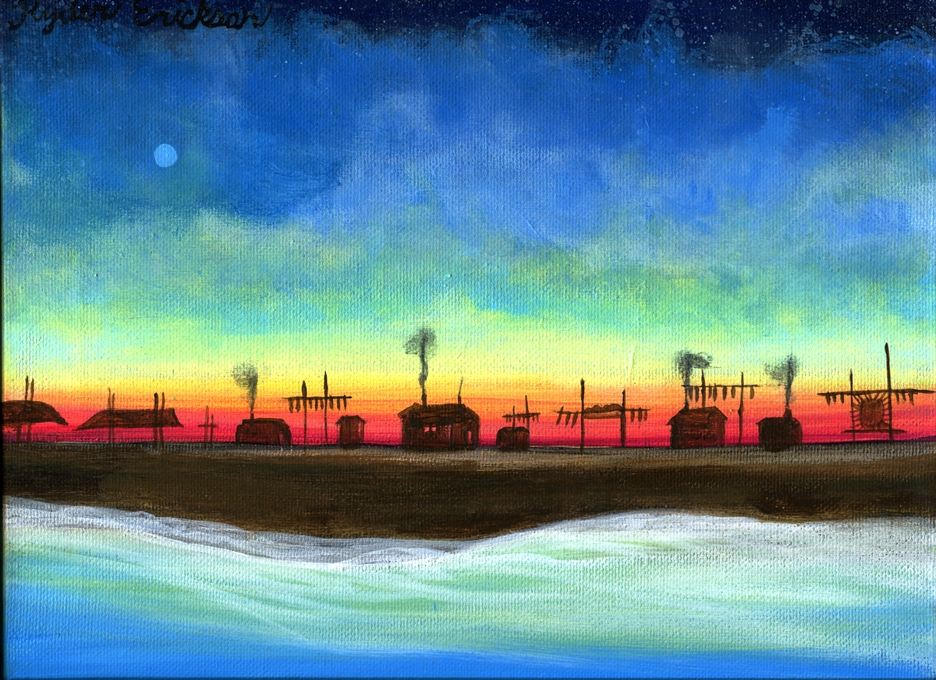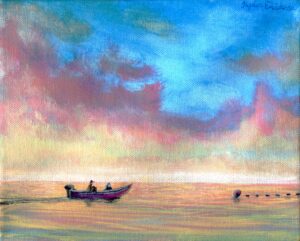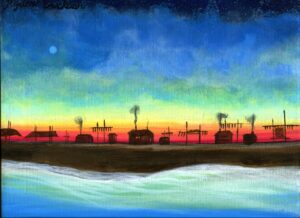
Self-taught artist paints rural Alaska life
Ryder Erickson makes paintings from his home in Unalakleet, Alaska. He’s a self-taught artist who recently supported Stickers for Conservation by contributing an image called “Shaktoolik Gold.” His work paints rural Alaska life, or what he calls growing up “village”.
Trustees for Alaska sponsored the production of 100 stickers for the project. Anyone who does a good deed for the planet—like donate to a conservation group, write a letter to a legislator, educate others about the environment—can make a sticker claim.
We recently asked Ryder to talk about his work and the issues that matter to him. We edited his responses for length. Read part 2 of the interview to find out what Ryder works to protect.
Coming to art early in life
From an early age I was interested in art and was encouraged to draw from as far back as I can remember. My parents always provided me with paper and art materials and saved many of my drawings. I loved the way I could see things in my mind and then attempt to recreate them in two dimensions.
No matter what mood I was in—angry, frustrated, bored, or content—I was able to express myself through a pencil and paper. As the years went by I kept drawing, carrying a sketchbook with me through elementary, middle and high school.
As a self-taught artist, I didn’t really have any mentors; however, I was greatly influenced by several Inupiat artists from my extended family. When I was small, my mother showed me the work that her uncle James “Kivetoruk” Moses had done, and told me that he was my namesake.
I also had a book called “Alaskan Igloo Tales” by Edward L. Keithann. It was full of Eskimo folklore stories, but the most interesting aspect of the book was the illustrations, done by my grandmother’s cousin George Aden Ahgupuk. Another artist whose work I loved was Wilbur Walluk. He was my mother’s uncle as well. His art, like George Ahgupuk’s work, showed me the power of the line drawing in creating representations of Inupiat Eskimo culture, folklore, landscapes and wildlife.
Growing up “village”
In rural America, there are usually terms to describe someone who comes from a small town or has a rural background. Some are more positive, while some can be pejorative. Growing up “village” as I use it describes the lifestyle that comes with being brought up in rural Alaska, where subsistence and strong values are at the core of what is deeply ingrained in us from an early age. We grow up hunting, fishing, and gathering–learning skills that were passed down from generation to generation.
A love and respect for the land are also a large part of this, an appreciation for what it can provide and a knowledge of how harsh it can be. Being a villager means having a sense of community, the fact that we are all in this together, yet still surviving in what some would call a dangerous place with the passing seasons.
I apply this term to my art to describe where I am coming from, with a mixed heritage of Scandinavian and Inupiat Eskimo culture, and my attempt to preserve traditional history and Native lifestyles in some small way by depicting it in my work.
To some, growing up “village” can seem like a strange term, but to me it means interacting with the outside world but still keeping the core values and beliefs that come from a rural upbringing. I hope to create a sense of joy or curiosity with my artwork, and share some of the culture that one only encounters when they live in a rural Alaskan village for an extended amount of time.
Read part 2 of Ryder’s interview to learn about how rural Alaska life connects to a globally changing climate.





